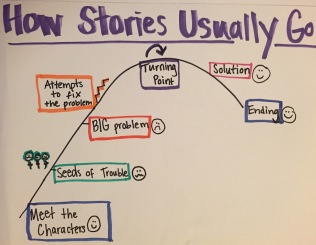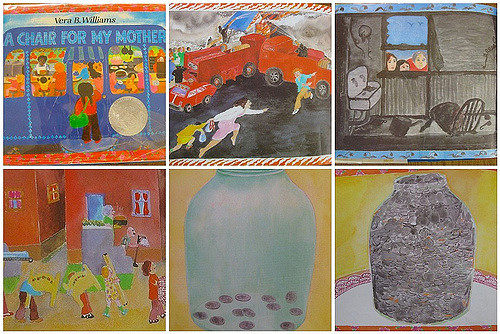Retelling is a perfect skill to work on at the beginning of the school year. It’s the foundation for so much of the deeper comprehension work that you’ll do as the year goes on. Sometimes, though, getting kids to retell can feel like pulling teeth. (Just say what happened! Just tell it in order!)
When this happens, the cause often comes down to our text selection (our own pick of the lit, you might say.)
Children’s literature often seems deceptively simple. However these books, like all narrative text, can be organized with a wide variety of plot structures. The more complex the plot structure, the harder the text will be to retell.
Take, for instance, Vera B. William’s A Chair for My Mother. Its 32 pages and brightly colored illustrations might make it seem uncomplicated. But in these 32 pages, readers must navigate a flashback, as the narrator remembers when the family’s old apartment burned down. The action then returns to the present and the quest for the chair. This text might present the first opportunity some students will have navigating a text that doesn’t follow a chronological timeline. Retelling here would require students to have understood that the story went back in time and returned to the present, and then to be able to reorganize that information in order to retell.
 Robert McCloskey’s classic Blueberries for Sal is another text that appears simpler than it actually is. We could call this a “meanwhile” story. McCloskey alternates between telling us what Sal and her mother are doing and what the baby bear and the baby bear’s mother are doing. All of the action is happening simultaneously, but is relayed separately, presenting a challenge for a reader who must retell what Sal was doing and, meanwhile, what the baby bear was doing. Not so easy.
Robert McCloskey’s classic Blueberries for Sal is another text that appears simpler than it actually is. We could call this a “meanwhile” story. McCloskey alternates between telling us what Sal and her mother are doing and what the baby bear and the baby bear’s mother are doing. All of the action is happening simultaneously, but is relayed separately, presenting a challenge for a reader who must retell what Sal was doing and, meanwhile, what the baby bear was doing. Not so easy.
As teachers, then, text selection is key to the success of any reading lesson in which we aim to teach retelling. We must examine books with the lens of plot organization and choose according for our students’ needs. If students struggle, we should treat plot structure as a continuum along which we can move students in their retelling work, moving from the most basic structures to the more complex.
Here is a list of some plot structures commonly found in picture books, arranged from easiest to most difficult, along with titles that fit the category. Use these lists to guide your students to become master retellers!
1. Beginning, Repetitive Pattern, Ending
This is the most simple of narrative structure, and thus the simplest to retell. The story begins, something keeps on happening, then something might change to bring about the ending. Many early readers follow this structure, making the text predictable to decode and the plot easier to hold on to. 
Books that follow this plot structure:
- Worm Builds (Kathy Caple)
- The Little Red Hen (Paul Galdone)
- The Mitten (Jan Brett)
- Are You My Mother? (P.D. Eastman)
- The Very Hungry Caterpillar (Eric Carle)
2. Rising Action-simple
 After students have mastered the retelling of the “beginning, repeating pattern, ending” retell, they will be ready to retell stories with a simple problem/solution structure, also referred to as a Rising Action structure, represented in the image to the left. The mountain itself is lopsided, because so much more of a story is generally dedicated to the rise up to the problem and the attempts to solve it, than to the resolution of the story. The vast majority of children’s stories follow this plot structure. Variability for difficulty might come in the length of the “seeds of trouble” and “attempts to fix the problem” sections of the plot.
After students have mastered the retelling of the “beginning, repeating pattern, ending” retell, they will be ready to retell stories with a simple problem/solution structure, also referred to as a Rising Action structure, represented in the image to the left. The mountain itself is lopsided, because so much more of a story is generally dedicated to the rise up to the problem and the attempts to solve it, than to the resolution of the story. The vast majority of children’s stories follow this plot structure. Variability for difficulty might come in the length of the “seeds of trouble” and “attempts to fix the problem” sections of the plot.
Books with a simple rising action structure:
- Knuffle Bunny (Mo Willems)
- “The Kite” from Days with Frog and Toad (Arnold Lobel)
- Peter’s Chair (Ezra Jack Keats)
- Tillie and the Wall (Leo Lionni)
- A Weekend with Wendell (Kevin Henkes)
3. Rising Action -complex
These stories share a similar structure to the rising action-simple stories above, but that story mountain might have a few more peaks and valleys on the way up or down. You might even be climbing two mountains at once (hello, subplots!). These would be our stories with flashbacks, flashforwards, or large jumps in time, our “meanwhile” stories, stories with parallel plots, subplots, or stories with multidimensional problems. These could each have their own category, but for the purpose of picking books for retelling, if the text you are considering has any of these, know that it is going to present a deeper challenge.
Books with a complex rising action structure:
- A Chair for My Mother (Vera B. Williams)
- Blueberries for Sal (Robert McCloskey)
- The Summer My Father Was Ten (Pat Brisson) –
- The Day Jimmy’s Boa Ate the Wash (Stephen Kellogg)
- Pop’s Bridge (Eve Bunting)
